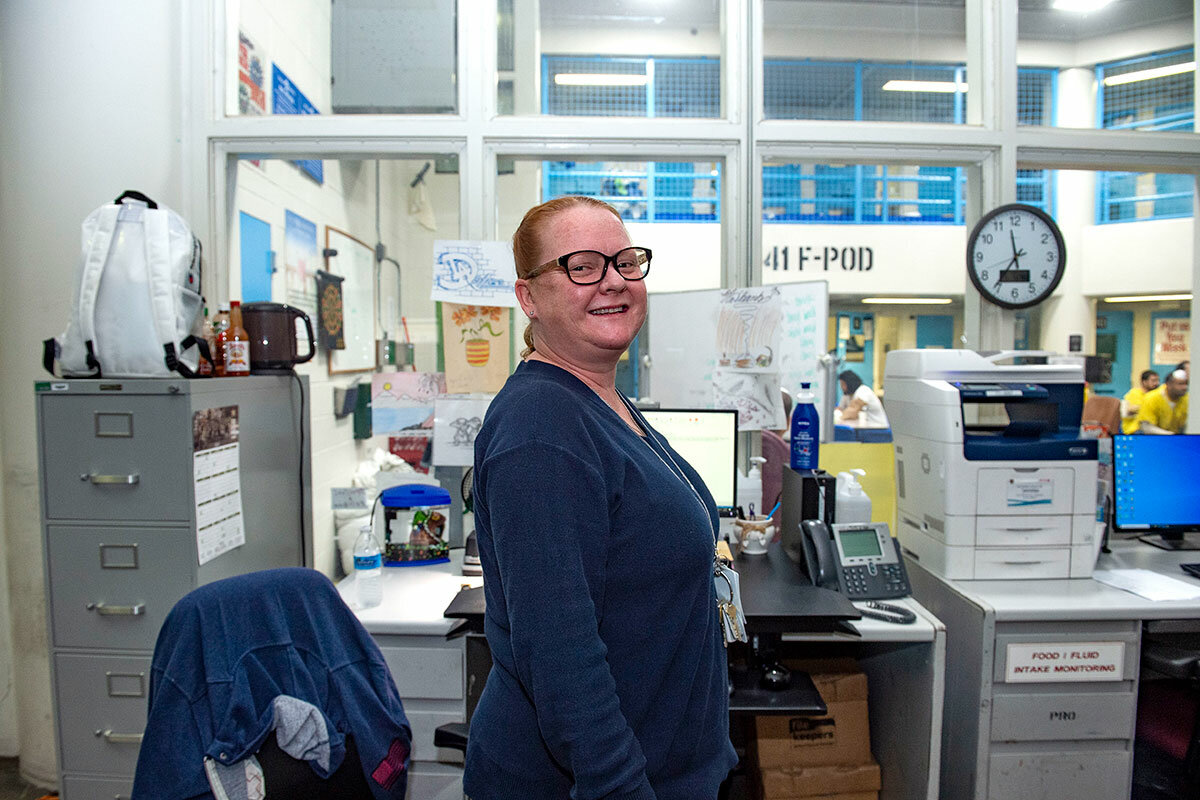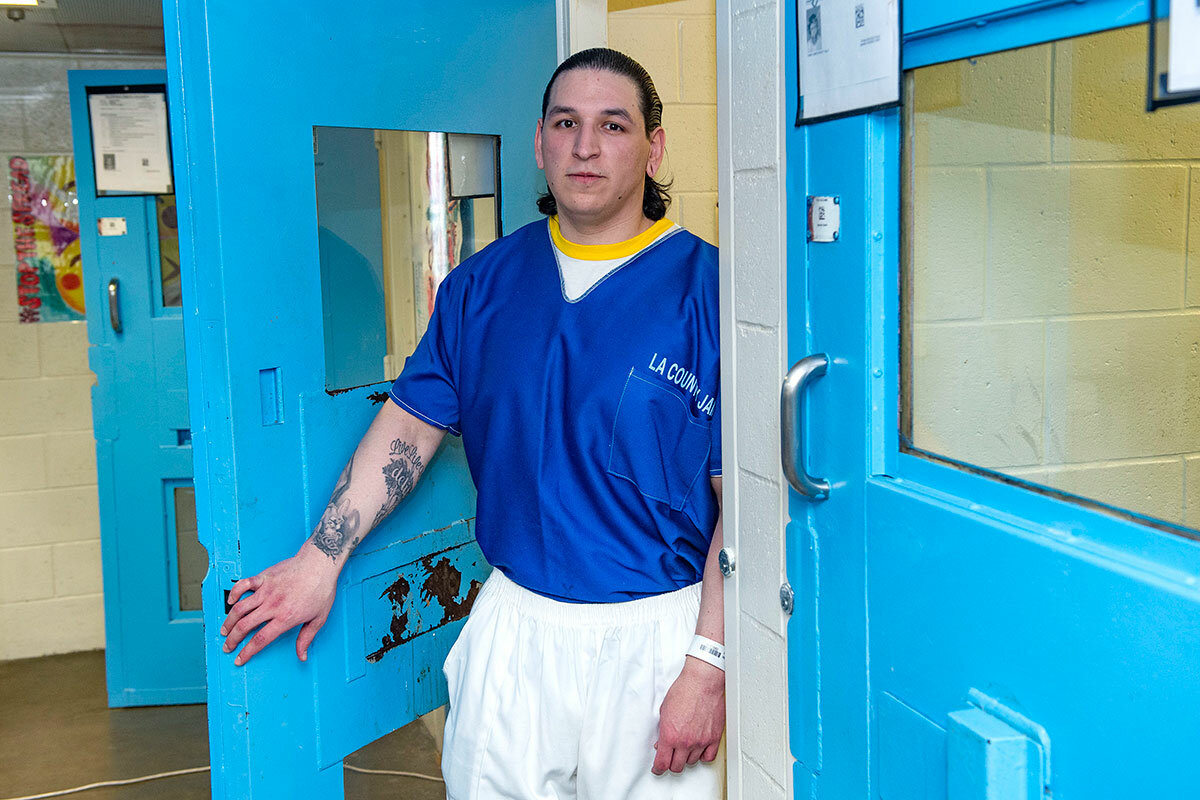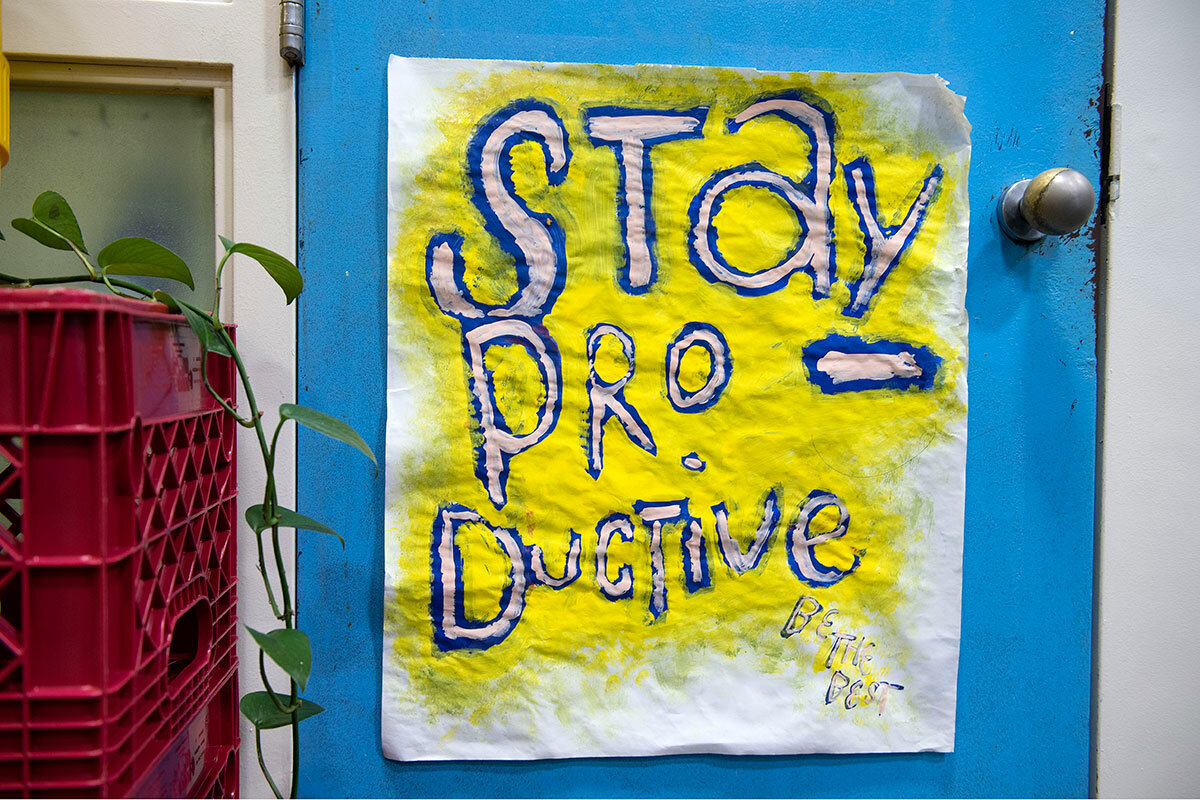From LA jail, two inmates pioneer care for mentally ill peers
Loading...
| Los Angeles
With more than 5,000 inmates struggling with mental health issues, the Los Angeles County jail is the largest jail system in the United States. It also holds another unofficial title: the nation’s largest mental health institution. That jail population has more than doubled in the past 10 years, with the imposing Twin Towers facility for men in downtown Los Angeles now devoted almost entirely to mental health inmates under “moderate” or “high” observation.
The men in high observation – numbering about 1,000 – reside in Tower 1.
When they are not in their cells, they are handcuffed to metal tables so they can’t harm themselves or others, and many are dressed in quilted robes to prevent self-harm. They live in pods of 16 cells that are often noisy and foul-smelling. As Joan Hubbell, the mental health programming manager for county correctional health services, admits, staff can’t keep up. Indeed, the jail operates under Department of Justice monitors to meet criteria for the treatment of mental-health inmates.
Why We Wrote This
From the squalid conditions of the Los Angeles County jail has emerged a potential model for how to address mental illness among incarcerated people. The secret? Care, on a daily basis.
But three pods on the fourth floor hold out hope for more humane and effective treatment. Officials are working to expand the nascent effort, affecting about 70 men in jail, to other floors, and some see it as a model for the nation. It’s a homegrown approach, developed by the on-site psychiatric technician, Sarah Tong, and taken to a new level by two “merit masters” from the general jail population, Craigen Armstrong and Adrian Berumen. With the support of Ms. Tong and others, they created a unique role for themselves as mental health assistants – living among those who are most severely ill, encouraging them to take medication (but not administering it), updating health professionals and custody officials on behavior, and adding more structure to a program that uses incentives to teach basic hygiene and other life skills.
Most important, the duo express consistent love and care toward the men. “It’s so simple, it’s profound,” says Ms. Hubbell. “They so understand how badly they want to be given a second chance and don’t want to be dismissed by people’s preconceived notions of them. It drives them to give [others] a second chance.”
The results are beyond the expectations of everyone, from a top assistant sheriff for the county to the mental health professionals. Self-harming is six times less, compared with other units, according to Ms. Hubbell. Discharging the incarcerated men from the forensic inpatient hospital to this program, known as Forensic Inpatient (FIP) Stepdown, has reduced returns to the hospital by 35%. Beyond the data, you can see the difference in the patients’ eyes and relaxed faces, she says. Outside their cells they are uncuffed (a deputy is always present), attending group therapy, and working as a team on “double scrub” Mondays, when Mr. Armstrong and Mr. Berumen assign chores to clean the two-story pods from top to bottom.
“When you walk in there, it doesn’t smell. It’s not noisy; it’s clean. People are not freaked out in their cells. They’re not bashing their heads against the walls. They’re not throwing their feces,” says Philippe Bourgois, a professor of psychiatry and anthropology at the University of California, Los Angeles who leads the Center for Social Medicine there. He volunteers at Twin Towers and is one of several key people, including FIP Stepdown’s director, Ms. Tong, who helped the two inmates build knowledge about mental illness.
“What people don’t understand about mental illness is that you become a social outcast,” says Professor Bourgois. The “brilliant insight” of the two inmates is that they figured out that human beings hate to be alone. They need friends. The assistants have already helped hundreds of people, he says. “This program has truly national and international potential for being a model.”
It was the idea of a jail captain to tap the men’s city jail for merit masters – inmates who have completed educational courses and can teach others – and bring them to Twin Towers. Prisons and jails run on inmate labor, but nothing like this, according to the National Association of Counties, which in 2020 honored the program with an achievement award. Peer-to-peer support from outsiders who are in recovery themselves is not unusual. But this is an inside job. As fellow inmates, Mr. Armstrong and Mr. Berumen are on hand 24/7, building trust and hearing and seeing things that others don’t. They bridge the gap between those struggling mentally and the health professionals and guards overseeing them, say those involved in the program.
More than just helping out, the two men sought to understand the experiences of those around them. Most are poor and homeless, and many have schizophrenia, says Ms. Tong. The vast majority are chronic methamphetamine users. Their offenses range from trespassing to murder.
Daily checklists hang outside each cell door: “AM Meds, Teeth, Shower, Clean Housing, Group, PM Meds, Monday Scrub.” Completing all in a week earns a person specially prepared meals on weekends. The “five-star” meals are a huge motivator, as are food and snacks generally – with coffee a favorite, and Dinty Moore Beef Stew a rare treat. Because they spend so much time with those behind cell doors, Mr. Armstrong and Mr. Berumen know what reward means the most to each one.
The two men spent weekend after weekend refining a curriculum on lifestyle habits, understanding the court, and self-education, which covers things like interpersonal communication. The nine-week course culminates with a graduation ceremony.
And they help facilitate group therapy sessions and therapeutic activities, like group karaoke and making colorful banners with inspirational messages. The banners hang in the pod common area, which Ms. Tong has made more homelike with huge, plastic rocking chairs, live plants, and a miniature fish tank with blue and red betta fish. Next on her list: an herb garden in the outdoor recreation area.
But is it possible to scale up something like this, which depends not only on teamwork, but also on the character and skill of inmate mental health assistants, who act as mentors?
Last year, Mr. Armstrong and Mr. Berumen self-published a book, “The Solution: Mental Health Assistants.” This road map to the program, which also covers the training of assistants, was written entirely with 3-inch pencils. It was formatted and brought to fruition by Kerry Morrison, the founder of Heart Forward LA, which advocates “radical hospitality” to transform America’s mental health system. In November, she posted a podcast interview with them and last month moderated a Zoom panel discussion about the program.
The Monitor was not able to talk with the two men directly, because their lawyers advised against it. According to court documents, Mr. Berumen is awaiting trial on June 2, facing charges of attempted murder, murder, and arson. After having his previous judgment overturned due to a juror issue, Mr. Armstrong is heading for a retrial Aug. 9 on multiple counts of murder, among other charges. A pretrial hearing is set for June 16. The prosecution is no longer seeking the death penalty for Mr. Armstrong.
In their discussions with Ms. Morrison, the two men talk extensively about what it takes to be a mental health assistant. “It’s a challenge living in the pod,” said Mr. Armstrong on the Zoom recording. “You’re being assaulted. You’re being disrespected a lot, and you have to figure out other ways on how to deal with that. ... But it takes a lot of self-restraint, a lot of tolerance, a lot of understanding, a lot of communication to treat the individual the way they should be treated.” He has spent hours outside a jailed patient’s cell door, just talking to that person.
Mr. Berumen says they look for keys when interviewing potential assistants. They must have completed three education courses, preferably one on anger management. How’s their appearance – are they combing their hair? Perhaps someone has a spiritual side. But the main thing they want to know is what challenges a person in jail has faced, and how he dealt with them. “We kind of know when a guy is pulling something over,” said Mr. Armstrong, in the November podcast.
With a combined 25 years incarcerated, they’ve had time for inner reflection. Both men emphasize the redemptive nature of this chapter in their lives. “I think the individual is created to grow,” said Mr. Berumen, the younger of the two, in the podcast. “The perfect opportunity to redeem yourself is to give back.” Everybody wants to be valued in life, he explained. “After so long, you start to look and you long to be of value to somebody, and then you start to see the individuals who do need you. And you find value.”
The program has had mixed results with other mental health assistants, according to Ms. Tong. That has slowed progress. But more recently, officials let Mr. Armstrong and Mr. Berumen interview close to a dozen men in jail, completely on their own, and “the two they chose are amazing.” The new assistants are in a third pod and the program is close to expanding to a fourth. “It’s going to take a lot of time, and it takes a specific kind of person to do it,” says Ms. Tong, of plans to expand.
“The whole idea of trying to replicate it and export it to other institutions and states and agencies is still in its infancy,” says Assistant Sheriff Bruce Chase, the law enforcement support behind the idea of mental health assistants. Best of all is to divert – or release – mentally ill people from prisons and jails into more appropriate settings, say both corrections and mental health experts. Los Angeles County does this to some extent, but treatment solutions are lacking in the community, according to Assistant Sheriff Chase.
“We have all these individuals accused of various crimes, ranging from minor to extremely serious, and we’re forced to deal with them in a jail setting rather than a mental health one,” he says. So the effort to expand the mental health assistant program continues, including bringing it to the county’s incarcerated women – a population of about 1,200, he says, where nearly 70% have been identified as having some level of mental health challenge.
“We have to start somewhere. If you think about trying to help everyone, you get overwhelmed and then decide you can’t do it because it’s too much,” he concludes. “If you incrementally do it, you can see the success and it becomes achievable in your mind. As we expand it and see the success, hopefully we can help a lot more folks.”









